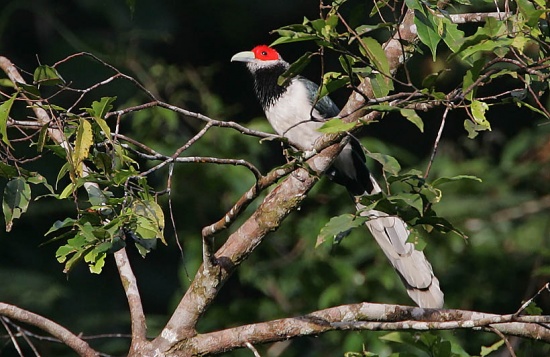m |
Charlirox099 (talk | contribs) |
||
| Line 3: | Line 3: | ||
[[Image:Red-facedMalkoha.jpg|thumb|550px|<br />Photo by {{user|Steve+G|Steve G}}<br />Sinharaja, [[Sri Lanka]], July, 2009]] | [[Image:Red-facedMalkoha.jpg|thumb|550px|<br />Photo by {{user|Steve+G|Steve G}}<br />Sinharaja, [[Sri Lanka]], July, 2009]] | ||
==Identification== | ==Identification== | ||
| − | 46 cm. | + | This is a large species at 46 cm with a long graduated tail. Its back is dark green, and the uppertail is green edged with white. The belly and undertail are white, the latter being barred black. The crown and throat are black, and the lower face white. There is a large red patch around the eye and the bill is green. Sexes are similar, but juveniles are much duller. The Red-faced Malkoha takes a variety of insects including caterpillars, giant stick insects, mantises and small vertebrates such as lizard. It occasionally may eat berries but this needs confirmation. |
| − | |||
==Distribution== | ==Distribution== | ||
[[Sri Lanka]] | [[Sri Lanka]] | ||
| Line 10: | Line 9: | ||
==Taxonomy== | ==Taxonomy== | ||
==Habitat== | ==Habitat== | ||
| − | + | The Red-Faced Malkoha is regularly seen at Sinharaja and few other remaining rain forests, frequents associating with feeding waves. It is also found in scattered riverine habitats in the dry zone, such as Lahugala, Wasgamuwa, Manik Ganga and Kubukkan Oya. | |
| + | |||
==Behaviour== | ==Behaviour== | ||
| − | It | + | It inhabits tall forest, and lives either solitary, in pairs, or in small flocks. It is shy and restless, a dweller in the tree canopy, where, like the last species, it cleverly threads its way through tangled twigs, creepers and foliage. |
| − | + | The breeding season is in the first half of the year and probably again in August-September. The nest is described as a shallow saucer of grass, roots and twigs, very carelessly put together, and placed in high bushes in forest with thick undergrowth. The two or three eggs are white, with a chalky surface, and they measure about 35.8 X 27 mm. | |
| − | |||
| − | |||
Revision as of 13:34, 21 September 2011
| This article is incomplete. This article is missing one or more sections. You can help the BirdForum Opus by expanding it. |
- Phaenicophaeus pyrrhocephalus
Identification
This is a large species at 46 cm with a long graduated tail. Its back is dark green, and the uppertail is green edged with white. The belly and undertail are white, the latter being barred black. The crown and throat are black, and the lower face white. There is a large red patch around the eye and the bill is green. Sexes are similar, but juveniles are much duller. The Red-faced Malkoha takes a variety of insects including caterpillars, giant stick insects, mantises and small vertebrates such as lizard. It occasionally may eat berries but this needs confirmation.
Distribution
Taxonomy
Habitat
The Red-Faced Malkoha is regularly seen at Sinharaja and few other remaining rain forests, frequents associating with feeding waves. It is also found in scattered riverine habitats in the dry zone, such as Lahugala, Wasgamuwa, Manik Ganga and Kubukkan Oya.
Behaviour
It inhabits tall forest, and lives either solitary, in pairs, or in small flocks. It is shy and restless, a dweller in the tree canopy, where, like the last species, it cleverly threads its way through tangled twigs, creepers and foliage. The breeding season is in the first half of the year and probably again in August-September. The nest is described as a shallow saucer of grass, roots and twigs, very carelessly put together, and placed in high bushes in forest with thick undergrowth. The two or three eggs are white, with a chalky surface, and they measure about 35.8 X 27 mm.




